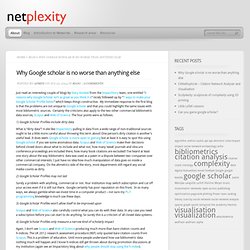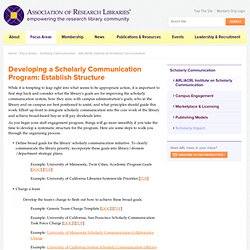

4 reasons why Google Scholar isn’t as great as you think it is. These days, you’d be hard-pressed to find an academic who doesn’t think that Google Scholar Profiles are the greatest thing since sliced bread.

Some days, I agree. Why? Because my Google Scholar Profile captures more citations to my work than Web of Knowledge or Scopus, automatically adds (and tracks citations for) new papers I’ve published, is better at finding citations that appear in non-English language publications, and gives me a nice fat h-index. I’m sure you find it valuable for similar reasons. And yet, Google Scholar is still deeply flawed. Why Google scholar is no worse than anything else. Just read an interesting couple of blogs by Stacy Konkiel from the ImpactStory team, one entitled “4 reasons why Google Scholar isn’t as great as you think it is“ nicely followed up by “7 ways to make your Google Scholar Profile better“ which keeps things constructive.

My immediate response to the first blog is that the problems are not unique to Google scholar and that you could highlight the same issues with most bibliometric sources. Certainly the criticisms also apply to the two other commercial bibliometric data sources, Scopus and Web of Science. The four points were as follows. 1) Google Scholar Profiles include dirty data.
Knowledge: research, expertise at ESSEC BusinessSchool. Présence numérique : habitus et pratiques savantes. Researcher profiles - Research impact & Visibility - LibGuides at Utrecht University. The Utrecht Unviversity staff profile pages are available since Spring 2013.

You can add your CV, profile and list additional functions (free text). It also lists your publications as entered in the University Research Information System Metis. Often this is done for you by the faculty or department administration once every 3, 6 or 12 months. However, one thing you can do yourself is upload the full text of publications to make these more visible. 1) Go to your UU profile page and start editing by logging in top right.
Image uploaded by @library_connect. Microsoft Word - Do HCR Successfully use the Social Web (preprint) - Do HCR Successfully use the Social Web (preprint).pdf. Beyond the paper CV and developing a scientific profile through social media, altmetrics and micropublication « ChemConnector Blog. This is a presentation that I will have delivered twice here in the UK this week… Beyond the paper CV and developing a scientific profile through social media, altmetrics and micropublication Many of us nowadays invest significant amounts of time in sharing our activities and opinions with friends and family via social networking tools.

However, despite the availability of many platforms for scientists to connect and share with their peers in the scientific community the majority do not make use of these tools, despite their promise and potential impact and influence on our future careers. We are being indexed and exposed on the internet via our publications, presentations and data. We also have many more ways to contribute to science, to annotate and curate data, to “publish” in new ways, and many of these activities are as part of a growing crowdsourcing network. Tweet Your Pubs: How Altmetrics are Changing the Way We Measure Res...
Réseaux sociaux pour les chercheurs - A lire ou à relire. Protection et propriété des données sur Academia.edu et ResearchGate. Developing a Scholarly Communication Program: Establish Structure. While it is tempting to leap right into what seems to be appropriate action, it is important to first step back and consider what the library’s goals are for improving the scholarly communication system, how they sync with campus administration’s goals, who in the library and on campus are best positioned to assist, and what principles should guide this work.

Effort up-front to integrate scholarly communication into the core work of the library and achieve broad-based buy-in will pay dividends later. As you begin your staff engagement program, things will go more smoothly if you take the time to develop a systematic structure for the program. Here are some steps to walk you through the organizing process. Define broad goals for the library' scholarly communication initiative. To clearly communicate the library priority, incorporate these goals into library/division/department strategic plans. Example: University of Minnesota, Twin Cities, Academic Program Goals [DOC] [PDF] Charge a team. Should You Share Your Research on Academia.edu? Academia.edu’s motto, “share research,” may sound like a godsend to scholars who want to do everything possible to make sure their work echoes far beyond the ivory tower.

The pared-down social network lets users connect with colleagues, post their own publications, and track the readership of their work—all without having to dig through photographs of people’s cats and reactions to whatever is on TV. It’s a message with resonance, as the site’s growth bears out. More than 7 million people have created academic profiles on the site, says Richard Price, the company’s founder and CEO, with more than 800,000 joining each month. “Around 25 percent come back each month,” he says, “which is a return rate comparable to Twitter’s.” But the appeal of that motto is precisely what worries publishers like Elsevier, the self-declared “leading provider of science and health information.” There’s generally no additional action taken against the author, and there is an opportunity for appeal. Outreach Resources for Researchers and Scholars. Pour une utilisation critique des réseaux sociaux académiques.
L'Identité Numérique du Chercheur (avec tweets) · VanessaSuzzoni. (21) Twitter / Recherche - #matinée2014... De la trace à la présence numérique : (re)construction de l’identit... Comité d’éthique du CNRS - Promouvoir une recherche intègre et responsable -Un guide- Ce guide se veut formateur en offrant un cadre de discussion et de réflexion collective.

Il a donc vocation à s’enrichir du dialogue qui s’instaurera entre les acteurs de la recherche. Son contenu sera actualisé par le COMETS en prenant en compte l’évolution des sujets qui y sont traités. Comme le précise l’avant-propos rédigé par la présidente du comité, Michèle Leduc, "la nécessité d’une sensibilisation aux pratiques responsables de la recherche est devenue d’une actualité pressante, particulièrement pour les jeunes. Réseaux sociaux académiques….Le débat ! Ce sujet est au cœur de débats passionnants qui ont lieu sur le web en ce moment (listes de diffusion [accesouvert], [accestresouvert], carnets de recherche Rumor , blogs perso par exemple …etc) entre enseignants-chercheurs de toutes disciplines, éditeurs et professionnels de l’information scientifique et technique (IST) – bibliothécaires ou documentalistes.

En parallèle des informations et avis très pointus et importants sur les fonctionnalités techniques de chacune de ces plateformes très évolutives (Academia.edu, Researchgate.org, MyScienceWork…) : ergonomie, accès au contenu, citation des sources, interopérabilité, identité numérique du chercheur, pérennité et conservation des données… une nouvelle question semble émerger relative à la notion de métier. Et le libre accès dans tout ça ? Mapping Scientific Excellence. Home - Digital Science. Publish be cited, or perish. Academics’ online presence: A four-step guide to taking control of your visibility. ABOUT THIS GUIDE This guide is a starting point or improving your onlinepresence.

It suggests a range o tools or expanding andshaping your online presence, and outlines a number o strategies or taking your online visibility to the next level -your Online Presence 2.0. These suggestions are just a sliceo what is currently available – there are many alternativeplatorms, and new ones are being created all the timewhile older ones all away. To choose which tools and plat-orms to use, think about what you want to achieve.
At thesame time try experimenting with new platorms and ndwhat works the best or you. In today’s digital world, i you use the web, you have an online presence. Home - Scholarly Communication - Subject Guides at University of Otago. Digital Scholarship. Mendeley and librarians building bridges to make academic researchers more social and more productive. In this interview, William Gunn, Mendeley’s Head of Academic Outreach, discusses Mendeley as an academic social network.

He also talks about the librarian’s role in teaching researchers to use Mendeley, and how librarians themselves are using Mendeley to connect with colleagues with similar professional interests. Watch videos of the interview at Before Elsevier’s acquisition of Mendeley, the two companies collaborated on a number of fronts. Réseaux sociaux recherche (AB) Scholarly communication. 7 Habits of Networked Academics. Research impact « InfoDoc MicroVeille.